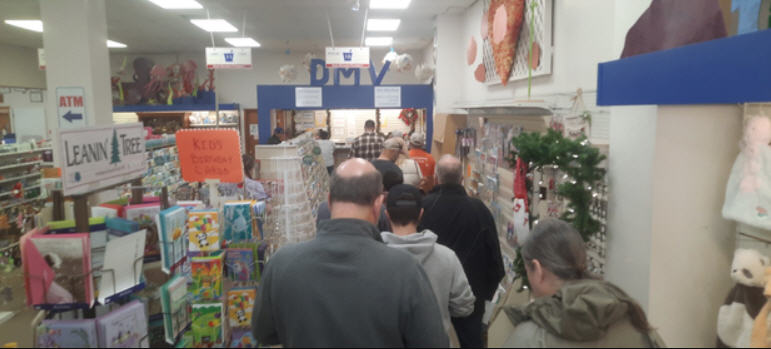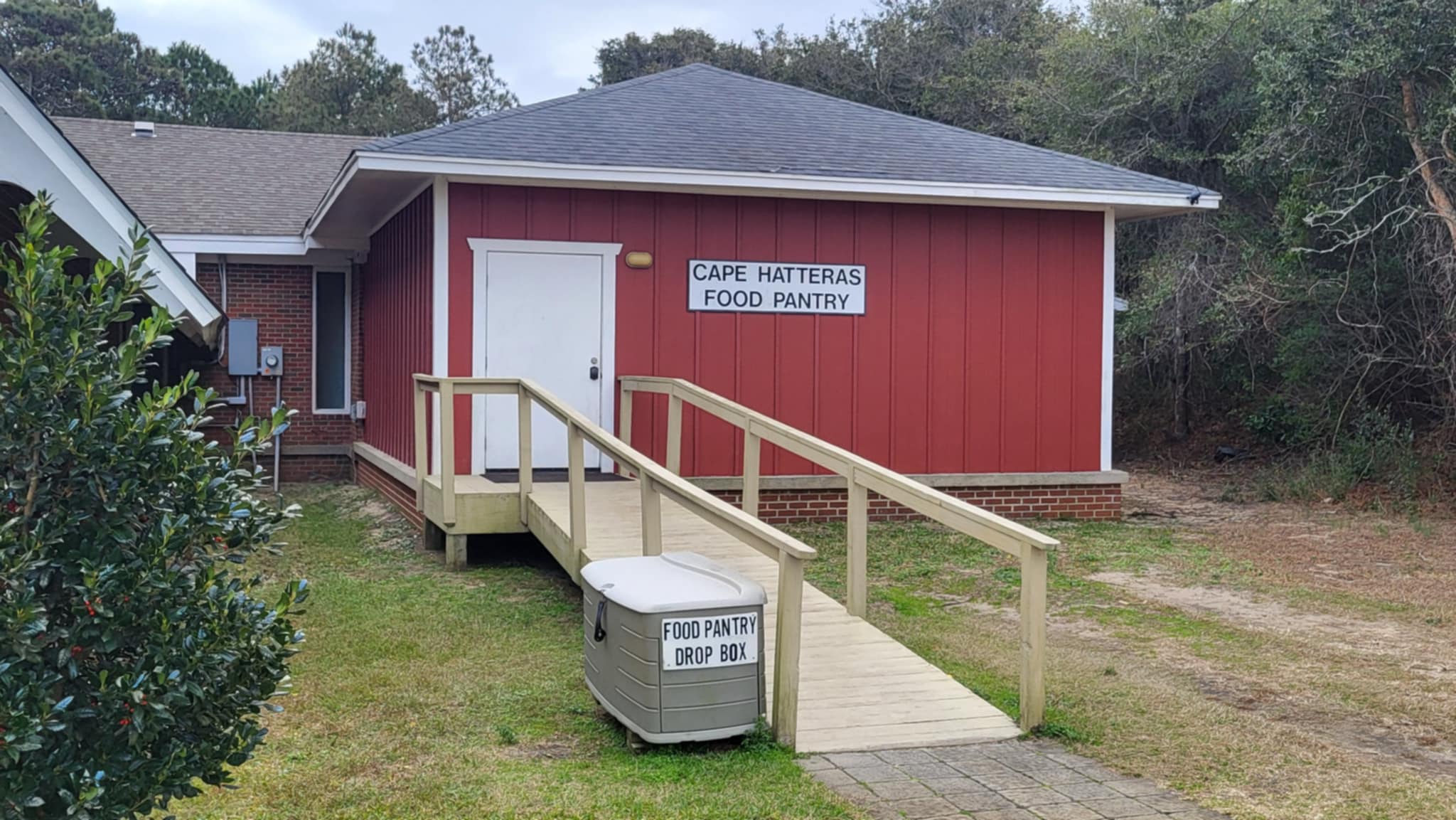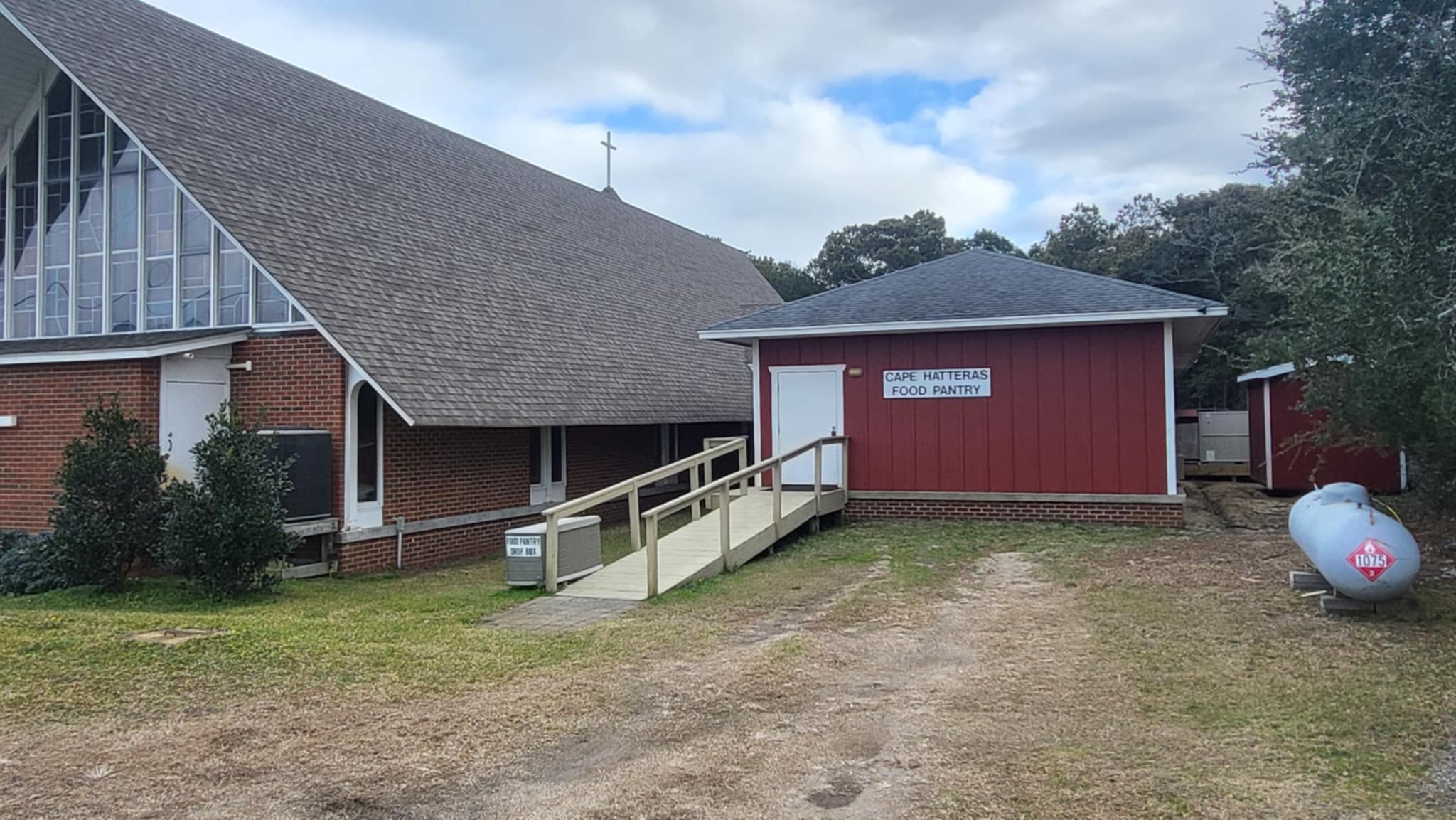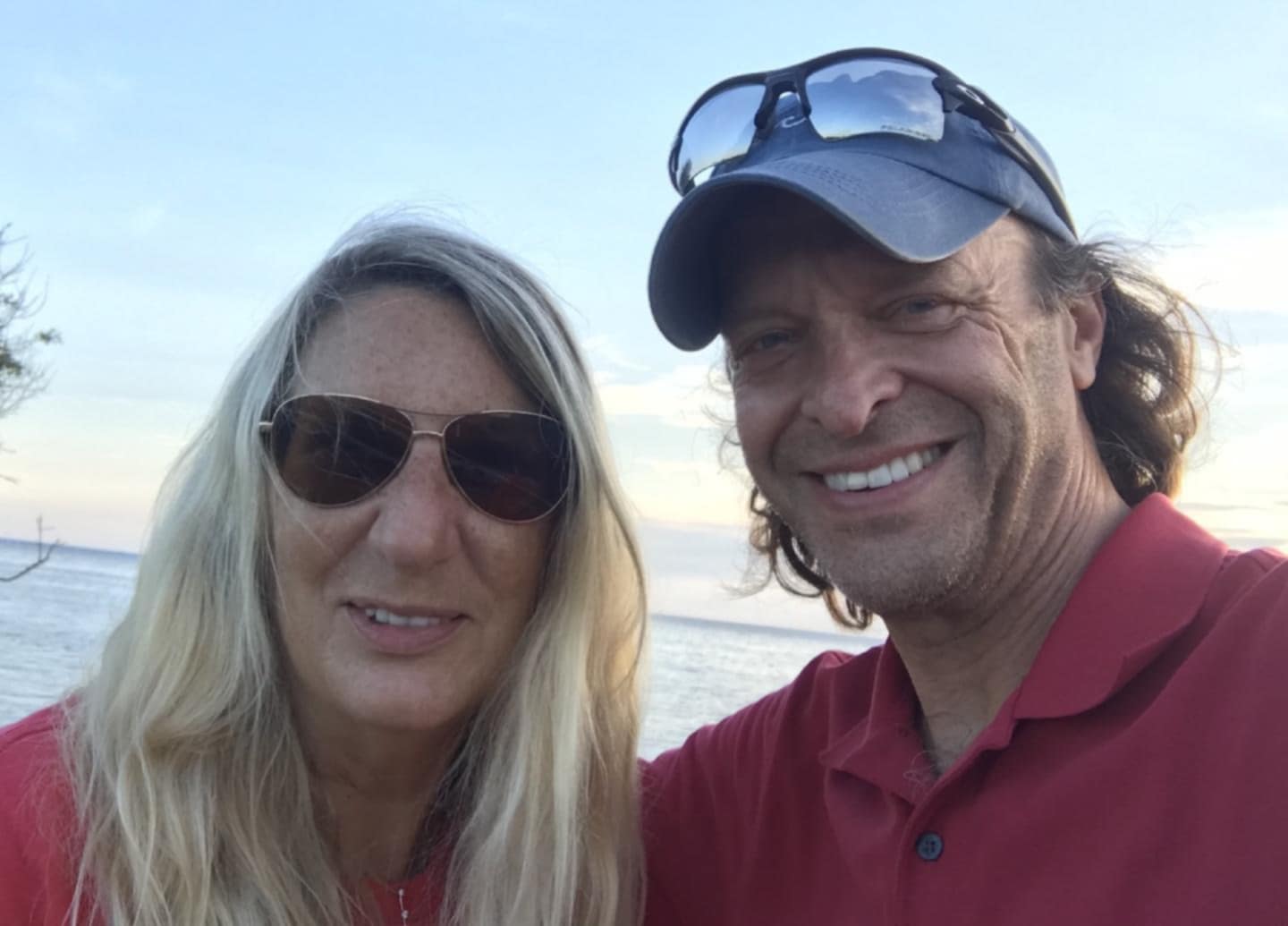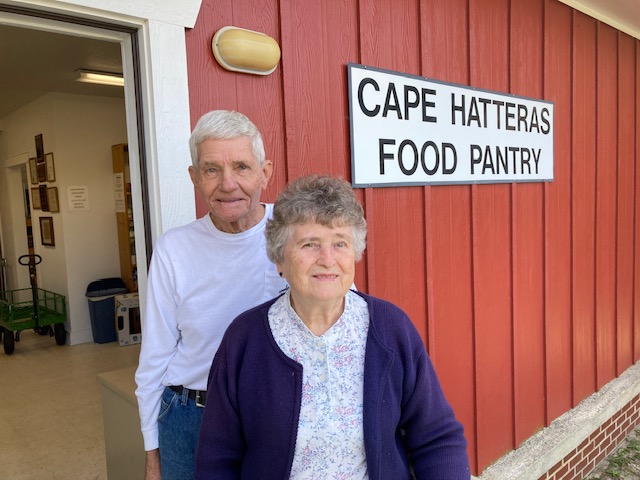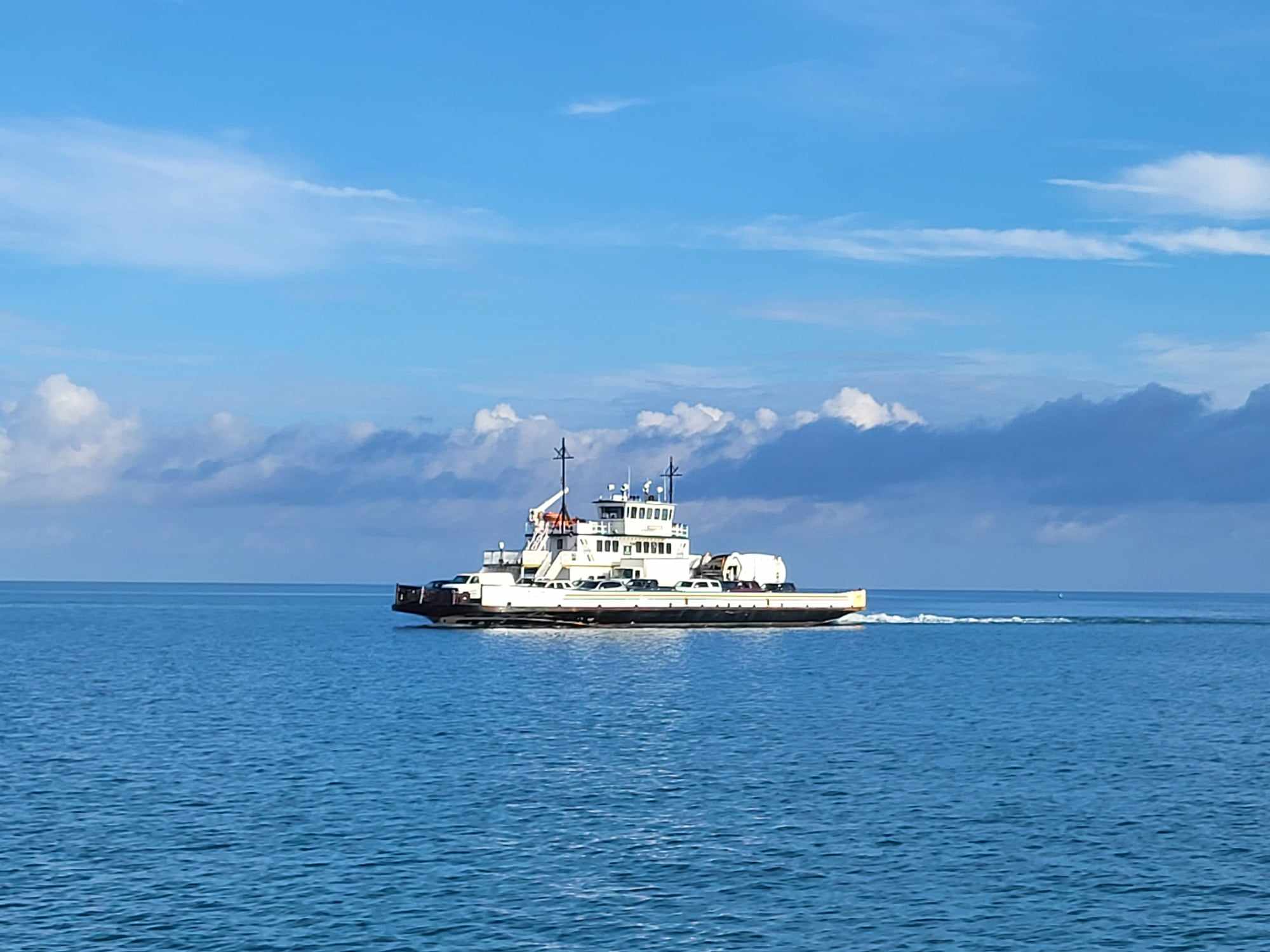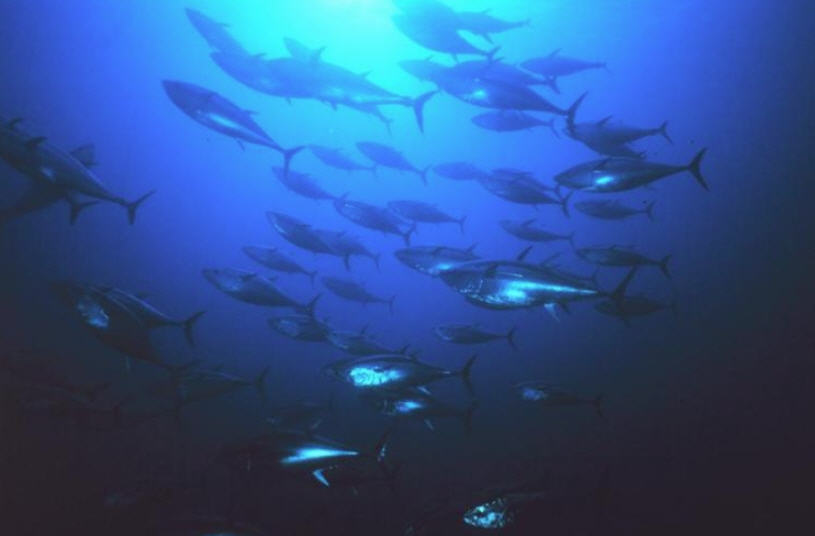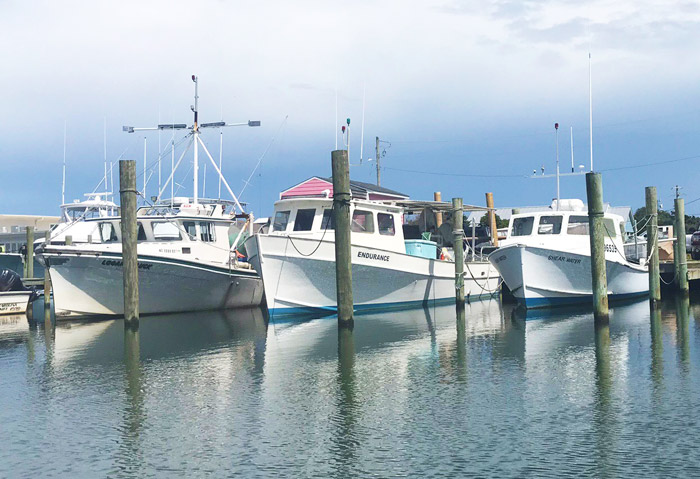Hatteras Charter Fishing: The Pioneer Years By ERNIE FOSTER
Before there were paved roads, before there were bridges, even before there was electricity on Hatteras there was charter fishing. And men named Vernon Willis, Nelson Stowe, Luther Burrus and Ernal Foster took anglers to the Gulf Stream without benefit of radio, Loran, or sonar.
These men were the pioneers and the business they began has evolved into the economic backbone of Hatteras village, rivaling and perhaps surpassing commercial fishing in its importance.
Sportfishing began in earnest in Hatteras in the 1930s. During those times large tracts of land throughout the Outer Banks were owned by “hunting clubs” whose members were primarily wealthy sportsmen from the northeast. The Gooseville Gun Club, for example, had its clubhouse at the site of the present Hatteras Inlet Coast Guard Station and owned all to the land from the present ferry docks to the inlet — land which was off-limits to locals. These sportsmen and others not only hunted for sport, they also had an interest in an activity known as “angling.”
At the time, the economy of Hatteras consisted primarily of commercial fishing. In the sounds, there were pound nets and set nets, and there was also a flourishing drop net fishery in the ocean. Boats of local design, with round sterns and a work platform on that stern, were built in several locations in the village and more than 30 of them were fished in the ocean. Typically such a boat had a single gasoline car engine with no clutch –no reverse — unless some enterprising captain installed the engine with car clutch assembly intact.
The handful of tourists who visited would occasionally persuade one of the commercial fishermen, such as Vernon Willis, to take them “sportfishing” in his boat, the Willis. The anglers supplied the tackle and sat on wooden fish boxes. Outriggers were unknown and rod holders were non-existent and the “catching of fish for fun” was viewed with great skepticism by the local populous.
However, Diamond Shoals Lightship was only 21 miles from the inlet, and, along the way, were the No.2 buoy and the shipwrecks of Diamond Shoals. The lightship was a perfect dolphin magnet, and the amberjacks on the wrecks were more than a match for the limited tackle available at the time. Inshore waters teemed with bluefish and mackerel and, in the spring and fall, channel bass. It was an angler’s paradise, but in a village where even a meager living was difficult, the idea of catching fish for any purpose other than the market or personal consumption was a strange, strange notion indeed.
It was during this hesitant beginning that a young man named Ernal Foster returned to his native village, forced “back home” from Long Island by the desperation of the Great Depression. With no job and no options but a breadline, he chose to leave a place he had grown to love and returned to his family and fishing. However, a family with a father and four boys, of which Ernal was the oldest, is too big for one boat and Ernal decided to have his own.
IN THE BEGINNING
A voyage in the family boat was made to Buffalo City (near East Lake on the mainland) and wood was purchased. The juniper planks were cured for more than a year before construction began on the Albatross at Willis Boat Yard in Marshallberg, N.C. Ernal had an absolute idea about the design for his boat and it was to be built his way or no way. Five builders turned him down before Milton Willis accepted the job. That negotiation was finally resolved when Ernal argued, “Look, it’s my wood and it’s going to be my boat, and if it doesn’t work, it’s my fault!”
In the spring of 1937, at a cost of $550, the Albatross was launched and is still sailing charters today – after 75 years.
Now Ernal had an advantage. As a 13-year-old, while his family lived in Beaufort, N.C., he had used the family boat to ferry “Sunday beachgoers” between Atlantic Beach and the Morehead City docks. He knew you could make money from tourists. So why not mix tourists and fishing?
In that first summer of 1937, he and his 16-year-old brother, Bill, ran four charters at $25 per trip. Serious charter fishing was launched in Hatteras.
What made Ernal different was his belief that charter fishing would work, a belief that was strengthened when the next season brought more business, including groups of fishermen needing more than one boat. Getting their business required a commitment from other captains, but those commitments were occasionally broken when it seemed that a commercial trip might be worth more than $25 a day. In his mind, you still needed to commercial fish in the off-season, but sportfishing would always come first, no matter what. And if you gave your word that you would take some angler fishing, then commercial fishing would have to take a back seat. To avoid broken promises to his customers, he needed more boats.
During this time frame, sportfishing was growing dramatically in Florida and the Bahamas. Capt. Tommy Gifford of Florida, who is credited with much of what now is considered standard boat equipment from fighting chairs to outriggers, was being watched and imitated by other captains. Not only were fellow Florida captains taking notice, there was also a handful of captains from Ocean City, Md., and Montauk, N.Y., who would fish “up-north” in the summer and “down-south” in the winter, and they, too, were paying attention.
Several Florida guides had also paid Hatteras a visit. It was these travelers who provided the local fishermen with the information and equipment they needed. Outriggers made of bamboo imported from the Orient to Miami in great bundles as deck cargo and ultimately carried up the coast on the northbound sportfishing boats made their way to Hatteras. Rod holders were introduced. Bait rigging techniques were shared. “Knucklebuster reels” gave way to star drag systems. And crude domestic bamboo fishing poles gave way to split bamboo works of art.
In the summer of 1939, an experienced angler named Hugo Rutherford came to Hatteras. Fishing on his private boat, he landed the first two marlin ever taken off Hatteras, one a 590-pound fish. But 1939 was a troubled time with the first stirrings of the winds of World War II gusting about. In such times that little piece of angling history was mostly forgotten.
For another season the fishing continued. Ernal caught the first sailfish ever taken off Hatteras, a seven-foot specimen, which was caught in an area now known as “the bad bottom” and then the war came.
AFTER THE WAR
It was 1946 before any sense of normalcy returned. The Albatross had been forced into military duty by the Coast Guard, numerous ships had been turned into fabulous artificial reefs courtesy of German U-boats operating off the coast during the early stages of the war, the public was looking for recreation, and Ernal had plans to build a fleet of charter boats.
The fledgling clientele of anglers wishing to fish Hatteras prior to the war returned with friends. In the summer of 1948, the Albatross II was put into service, and the charter fleet of Hatteras included the Jackie Faye with Capt. Luther Burrus, the two Albatross boats with Capt. Ernal and his brother Capt. Bill Foster, the Ursula with Capt. Nelson Stowe, and the Willis with Capt. Vernon Willis. Business was brisk.
The tackle was a limiting factor in the good old days. The linen fishing lines required regular drying to avoid rot. Bamboo fishing poles were still the norm, and artificial lures (feather jigs) were used. Occasionally croakers were used to catch amberjacks, and the favorite lure for catching Spanish mackerel was the hollow bone of a loon’s leg. Technology has since moved angling far, far away from the early days but, even though much of today’s equipment is superior, feather jigs, though not durable, still out catch nylon jigs, and in those days in Hatteras, shrimp were very abundant and cheap. It took a picky dolphin to turn down a fresh, peeled shrimp folded around and completely hiding a hook.
The boats could cruise at 8 to 10 knots — which meant they were always trolling — and the radios weighed 50 pounds. No one had any other electronics. With no Loran, no depth recorders, and no radio direction finders, navigation was accomplished with a watch, a compass, and dead reckoning. The fishing grounds ranged from what is now the 40250 Loran-C line southwest to the area of the oil slick wreck. Diamond Shoals Lightship was anchored around the 40230 line in 30 fathoms of water and four miles away was the “watch buoy.” Both the ship and the buoy were superior fish attractors, especially after they became slightly fouled with marine growth.
The oil slick wreck was easy to find. Torpedoed in 1942 by a German submarine, the oil tanker Lancing gave off an oil slick four to six miles long. The local fishermen simply found the slick and then followed it up current until it ended — over the wreck where amberjacks and king mackerel seemed to always be hungry. (This wreck still seeps oil but rarely produces anything close to the catches of the late ‘40s and ‘50s.) To the west of this wreck lies the Empire Gem or “smell wreck” — so named because it gives off a pungent odor of gas which, when detected, could be followed upwind to its source. And, by geographic good fortune, this was the general area where the edge of the Gulf Stream is found with its lines of sargassum.
These were the easy places to fish. Immediately after the war, the new shipwrecks, created by the U-boats were marked with buoys and they teemed with amberjacks. It was the older wrecks of steam vessels and sailing ships wrecked down through the ages on Diamond Shoals that allowed some of the local captains to demonstrate dead reckoning skills of a very high level. Using ranges from the barely visible beach and a seeming sixth sense they could find seven or eight wrecks in all but the most adverse weather conditions. When trolling was slow. they fished for sea bass — the wrecks on “the shoals” and the sea bass were always there.
CAPT. ERNAL’S BIG FISH
In looking at a history of the pioneering days of sportfishing in Hatteras, there may not be any event more significant than the fish caught by Ernal Foster on June 25, 1951.
By this time, he had begun to spend more and more time in the deeper waters out beyond the lightship, and he had begun to have consistent encounters with marlin — marlin too strong for the tackle used to catch the dolphins and the amberjacks that his customers wanted. His solution was to simply get a bigger rod and reel of his own and, independent of his customer’s wishes, he would troll a larger hook baited with a Spanish mackerel.
On this particular day, he decided to fish his new 9/0 Penn Senator with its 24-thread linen line (72-pound test), even though his customers protested. His youngest brother, Gaston, was working as mate. Having seen a marlin on the previous day, they were ready. And it was good that they were because the hoped-for marlin did not keep them waiting. Ernal, who happened to be in the cockpit at the time, hooked the fish. At this point, with the great fish jumping and Gaston at the helm, the charter customers once more let their resolve not to catch the fish be known. The crew then had two choices — either catch the fish themselves or cut it loose.
Having never seen a piece of line he wanted to waste by cutting, Ernal began the fight that changed the face of fishing in Hatteras. After 2 1/2 hours of struggle the 475-pound blue marlin was in the boat, and the Albatross II headed for port. The news of the catch spread up and down the Outer Banks, but that was only the beginning.
Enter Aycock Brown, who had recently been hired as the publicist for the Dare County Tourist Bureau in Manteo. Aycock had the perfect talents for the job he had been given. Blessed with an unending supply of enthusiasm and energy, he arrived in Hatteras the next morning, having taken the first possible ferry across Oregon Inlet. Aycock’s photo of the angler and his marlin made big news. It wasn’t just a local story. The picture was picked up nationwide and suddenly big-game fishing had arrived in Hatteras!
That bit of angling fame was enlarged upon the following summer when the husband and wife team of Ross and Betsy Walker arrived in Hatteras with the intent of fishing exclusively for marlin. And fish for marlin they did. Betsy Walker became the first woman to land a blue marlin in waters north of Florida. It was another first for the Albatross II and, again, with the help of Aycock Brown, marlin fishing in Hatteras made major headlines.
1953 was a pivotal year, for in that spring two brand new charter boats arrived in Hatteras. Until that time the charter fleet consisted of boats built for the dual purposes of both sport and charter fishing. But both of these boats, the Albatross III and the Twins, began service exclusively as charter boats.
The arrival of the Twins is particularly notable for it marked the entrance of Capt. Edgar Styron into the charter fishing business of Hatteras, and he was to have a major impact. Capt. Edgar operated out of the Blue Marlin Restaurant and Docks, the present site of the Hatteras Marlin Club, and in 1954, he added the Twins II to his charter business. In adding the Twins II, he introduced the first diesel-powered charter boat to the Hatteras fleet.
Capt. Edgar was an outspoken man, given a bit to deering-do, and he was a great fisherman. He caught marlin, lots of marlin, and he caught some of them very quickly, maneuvering the boat in what was then considered to be a bit of a reckless manner, but what is now accepted as standard maneuvering technique for fighting big fish. He popularized fishing on “the rocks,” an area which is now known as the “230” rock. He caught bluefin tuna in March. And he developed both a national and international clientele.
Among his captains were Capt. Clam Stowe and Capt. Elmer Balance, and it was during the years that the Twins and Twins II ran charters that the pioneering days of charter fishing in Hatteras reached full bloom. (It is also worth noting that Capt. Edgar was a crew member on the Jersey Devil when she caught the only 1,000-pound marlin ever brought into Hatteras — a 1,028-pound fish that was the 80-pound line class record for a number of years.
THE 1950s WERE EXCITING TIMES
All the pieces were now in place, and the 1950s were exciting times to be charter fishing in Hatteras. Among the captains not previously mentioned who established themselves during these times were Capt. Ronald Stowe, who began operating charters in the Ronnie in 1951 (and later the Capt. Squid), and Capt. Oliver O’Neal, who was to captain the Albatross III for 25 years.
And it was during this decade that a fledgling industry began to mature. In the beginning, all the Captains were local watermen, men who were the sons of sons of fishermen. All of these men were commercial fishermen, and they understood the waters and the weather of Hatteras. It was this background knowledge that allowed them to adapt quickly to this “new fangled “rod-and-reel fishing.
However, the Gulf Stream is not a static fixture. From day to day, indeed from moment to moment, it presents an ever changing face. These changes result from many factors — prevailing winds, changing water temperatures, changing strengths of the currents of both the Gulf Stream and its constant opponent off Hatteras, the Labrador Current. Into this mix must be added the changing seasons and migratory patterns of the fish, which seem easily altered by the availability of baitfish — an availability which itself is influenced by factors having little connection to the meandering of the Gulf Stream.
The task facing these pioneer charter captains was the same task facing all fishermen. First, find the fish. Then devise a technique for catching them. Both tasks require skill and perhaps even more important, knowledge. For the pioneers of Hatteras charter fishing, the first task, finding the fish meant predicting which fish would be where and when they would be there. With no past history or base of knowledge, each season and every day was a new adventure. The second task is what technique to use to produce the best catches could be learned, in part from the few anglers from other places who came to visit. Such knowledge was of great help, but most of the lessons came from trial and error. Through one missed opportunity after another, through one bit of blind luck after another, and through day after day of searching, the secrets of successful Gulf Stream fishing off Hatteras revealed themselves.
Without any navigation equipment beyond a compass, a watch, and a radio direction finder, they began to accumulate a body of knowledge which made the “where and when” part of the fishing equation something much different than just luck. With practice and the native skills of a waterman, they quickly mastered the techniques of how to catch them. By the late ‘50s monofilament leaders, cable leaders, swimming mackerel, deboned mullets, squid rigs, strip baits, belly baits and double lines — along with flying gaffs, fighting chairs, and both the bucket and kidney harness — were all standard procedures. And this knowledge and skill produced results.
The Albatross Fleet, the Twins boats, the Ronnie, the Jackie Faye, the Escape and the Ursula now comprised the local charter fleet and a growing trend, a sign of the future, was set in motion as a number of “outside” private boats made Hatteras either their semi-permanent home or a major spring and early summer destination.
The future began to take shape even more clearly with the establishment of the Hatteras Marlin Club, which immediately developed the first of North Carolina’s billfish tournaments, the Hatteras Marlin Club Invitational Tournament. This tournament cemented Hatteras’ position as a major billfishing spot.
A CHALLENGE TO THE FLEET
It was during this time that a fishing club in San Juan became concerned that Hatteras was receiving some of the fishing limelight previously reserved for Puerto Rico as the world’s number one blue marlin hot spot. That club issued a challenge to the Cape Hatteras Billfish Club, a challenge that would decide the debate as to which port could claim the title of “Blue Marlin Capital of the World.”
The Cape Hatteras Billfish Club had been founded by a dentist from Norfolk, Dr. J.C. Overby, and was located at the present site of Hatteras Village Marina. The format of the proposed challenge was straight forward. Two competitions would take place, one in Hatteras the other in San Juan. Each club chose what it believed to be the best date to fish its respective port and a four-day event was then scheduled at each port. The host club provided seven boats and seven anglers (one angler per boat) with the visiting club’s seven anglers fishing as guests on each of the host boats. Each angler fished one pole and the cumulative team total for blue marlin would determine the team title.
In addition, the total number of marlin caught in the Hatteras tournament would be compared with the total caught in the San Juan tournament to determine the title of “Blue Marlin Capital of the World.” Although the anglers from Puerto Rico prevailed in the team competition, the bumper tags proclaiming Hatteras “Blue Marlin Capital of the World” are testimony as to the port in which the most marlin were landed.
In August of 1958, an angling event occurred that had a major impact on the sport of billfishing. The two principal participants were Capt. Bill Foster and an angler named Dr. Jack Cleveland. Dr. Cleveland and his new bride, Ellie, both serious anglers, were in Hatteras in pursuit of blue marlin. Blue marlin fishing was still a rare activity in those days. Fish of such size with strange bills and unusual fins so stirred the population that, whenever a fish was caught, it was hung up for photos and then left for several days to be observed by one and all. I still vividly remember the night in church when it was announced that my father, having battled a marlin for over four hours, would be getting to the dock not long after the service ended. It seemed to me that the whole village was there when he docked. His smile was the only illumination needed to insure that we all could see the wondrous fish.
In those days, conservation and ecology and environmental issues were not part of any public concern. If you caught a fish you kept it — period!
In such an atmosphere it probably is not possible to convey the surprise, the shock, the absurdity of what Capt. Bill and Dr. Cleveland did on that August day. First they caught the biggest prize in the Atlantic, a blue marlin and then they let it go — alive! Everyone was stunned to learn of what that crazy group on the Albatross II had done. Captains smirked and writers wrote stories. The concept of releasing billfish had found its way to Hatteras as two men, one a highly skilled captain and the other a sportsman in the truest sense of the word, began a trend which is so entrenched in today’s sportfishing culture that no one now gives such an action a second thought.
The pioneers were doing their work quite well. By the early 1960s, Hatteras was known far and wide as the place to go to catch a blue marlin. The Hatteras Marlin Club’s annual tournament was attracting international anglers and the fishing guides of Hatteras were recognized as men who knew how to catch blue marlin.
The final piece of the early puzzle facing these pioneer captains was put in place by Capt. Bill Foster. The sport had had its beginnings in Florida and the northeast. Hatteras had been a bit of a “new boy on the block” and the usual regional rivalries as to who was the best were floated back and forth from Florida and its sailfish, and Ocean City and its white marlin, and those new guys in Hatteras.
CAPT. BILL’S BIG FISH
What Captain Bill Foster did in June of 1962 was catch a blue marlin that weighed 810 pounds. It was the new all-tackle world’s record. When the Albatross II returned to port that afternoon, she was greeted by all the participants of the annual Marlin Club tournament, which was to begin the following day. From that point on, Hatteras and its fishermen were accepted as a fixture in the world of sportfishing.
In reflection on that first generation of sportfishing captains, it is clear that a changing of the guard began to occur in earnest during the mid-‘60s. After 20 years –one generation — the pioneer captains had done their work. An industry had been taken from its infancy to full maturity.
Captains who had no choice but to learn through trial and error had taught willing mates these hard earned lessons. Twenty-five years of knowledge acquired by trial and error could now be conveyed to a good mate in three. Captains who had learned where and when to go to certain “spots” were simply followed to those spots by captains who were moving to Hatteras from other places. The development of improved electronics — from depth finders to Loran, to temperature gauges — allowed for much easier continued exploration of the fishing grounds.
The charter fishermen who began fishing Hatteras in the mid-‘60s were free to refine fishing techniques, expand the fishing grounds with faster boats, and take advantage of improved technology to insure more consistency in the fishing than was possible before.
The present charter fleet of Hatteras is bigger and better than ever. The second generation of captains expanded and improved in every way. But each of us who now fishes owes this opportunity to the captains who preceded us — the ones who went where no one had gone before.
(Ernie Foster is the son of Capt. Ernal and now runs the Albatross Fleet with his wife, Lynne. The fleet celebrates its 75th anniversary this year, and the pioneering captains were honored at a celebration at the Albatross docks on Sept. 29.)


